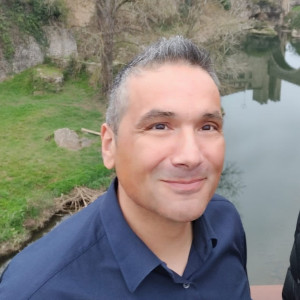Capítulos
To do, o "hacer" puede sonar como un verbo simple pero a la vez es muy útil. Es un verbo irregular, ya que en su forma basal es do, pasado simple es did y pasado participio es done. Como con todos los verbos, varían de forma dependiendo de su tiempo verbal. Veamos como se ve el verb to do en todos sus tiempos. Fíjate bien en como cambian tambien dependiendo del sujeto.

Formas
Present
El presente se usa para to do porque abarca acciones habituales, estados y hechos generales. El presente continuo doing, para acciones en curso o planes.
| Subject | Simple | Continuous | Example |
|---|---|---|---|
| HE | DOES | IS DOING | He does the laundry He is doing the laundry |
| SHE | DOES | IS DOING | She does her homework She is doing her homework |
| IT | DOES | IS DOING | It does a great job It is doing a great job |
| I | DO | AM DOING | I do yoga I am doing yoga |
| YOU | DO | ARE DOING | You do sports You are doing sport |
| WE | DO | ARE DOING | We do the dishes We are doing the dishes |
| THEY | DO | ARE DOING | They do their work quickly The are doing their work quickly |
Past
El pasado simple did se usa para to do porque abarca acciones completadas en el pasado y hábitos en el pasado. El pasado continuo was/were doing se usa para acciones en progreso en el pasado o dos acciones que ocurren al mismo tiempo en el pasado.
| Subject | Simple | Continuous | Example |
|---|---|---|---|
| YOU | DID | WERE DOING | You did everything you could to help. You were doing everything you could to help. |
| WE | DID | WERE DOING | We did a meeting last Friday. We were doing a meeting last Friday. |
| THEY | DID | WERE DOING | They did all the cooking for the event. They were doing all the cooking for the event. |
| I | DID | WAS DOING | I did my best to prepare for the test. I was doing my best to prepare for the test. |
| HE | DID | WAS DOING | He did the dishes. He was doing the dishes. |
| SHE | DID | WAS DOING | She did all the decorating for the party. She was doing all the decorating for the party. |
| IT | DID | WAS DOING | It did a strange clicking noise. It was doing a strange clicking noise. |
Present perfect
El presente perfecto simple have/has done se usa para to do cuando la acción está completada pero tiene relevancia en el presente, o para expresar experiencias. El presente perfecto continuo have/has been doing se usa para una acción que ha estado en progreso hasta el presente.
| Subject | Simple | Continuous | Example |
|---|---|---|---|
| YOU | HAVE DONE | HAVE BEEN DOING | You have done a great job. You have been doing a lot of work today. |
| WE | HAVE DONE | HAVE BEEN DOING | We have done our tasks. We have been doing our tasks all day. |
| THEY | HAVE DONE | HAVE BEEN DOING | They have done their project. They have been doing their project all week. |
| I | HAVE DONE | HAVE BEEN DOING | I have done my homework. I have been doing my homework for an hour. |
| HE | HAS DONE | HAS BEEN DOING | He has done his homework already. He has been doing his homework for an hour. |
| SHE | HAS DONE | HAS BEEN DOING | She has done her chores. She has been doing them all morning. |
| IT | HAS DONE | HAS BEEN DOING | It has done all the calculations for you. It has been doing the same thing for hours. |
Past Perfect
El pasado perfecto simple had done se usa para to do cuando una acción se completó antes de otra en el pasado. El pasado perfecto continuo had been doing se usa para una acción que estaba en progreso antes de otra acción en el pasado.
| Subject | Simple | Continuous | Example |
|---|---|---|---|
| YOU | HAD DONE | HAD BEEN DOING | You had done your homework by the time I arrived. You had been doing your homework for an hour. |
| WE | HAD DONE | HAD BEEN DOING | We had done our part of the project. We had been doing the project for several weeks. |
| THEY | HAD DONE | HAD BEEN DOING | They had done their research before the presentation. They had been doing the research for a long time. |
| I | HAD DONE | HAD BEEN DOING | I had done my work before the meeting. I had been doing my work all morning. |
| HE | HAD DONE | HAD BEEN DOING | He had done his chores before going out. He had been doing his chores all afternoon. |
| SHE | HAD DONE | HAD BEEN DOING | She had done the cooking when I got home. She had been doing the cooking for two hours. |
| IT | HAD DONE | HAD BEEN DOING | It had done all the work before the deadline. It had been doing the same task for hours. |
Verbo Auxiliar
El verbo "to do" funciona como verbo auxiliar en oraciones interrogativas y negativas en presente simple y pasado simple, cuando el verbo principal no es "to be". Aquí, no se traduce literalmente al español, ya que solo sirve para construir la estructura gramatical, es como de "apoyo" a la frase. Mira estos ejemplos:
- Do you like pizza? - ¿Te gusta la pizza?
- She doesn't play soccer. - Ella no juega fútbol
- Did you see the movie? - ¿Viste la película?
- We didn't go to the party - No fuimos a la fiesta
Como respuesta corta
El verbo "to do" también se emplea en respuestas cortas, para evitar repetir el verbo principal de la oración anterior. Esto no recomiendo usar cuando en clases te pidan dar respuestas "completas" ya que te estas saltando escribir una frase con todo sus componentes.
- Do you like coffee? – Yes, I do.
- Did she finish her homework? – No, she didn't.
- Does she know the answer? - No, she doesn't.
- Did they finish the project? - Yes, they did.
- Do we need to leave now? - No, we don't.
En resumen, el verb to do lo usamos cuando necesitamos dar enfasis en que estamos haciendo, hicimos o queremos hacer. Verán que lo usan mucho en lo ultimo que mencionamos, en respuesta a preguntas. Será como su atajo a generar conversación y respuestas.













El cuarto deberían poner negativo interrogativo
¡Hola María! 😊 Gracias por tu comentario.
En este ejercicio estamos practicando el presente simple negativo con «to do», por eso todas las oraciones están enfocadas en esa estructura.
En el ejercicio cuatro:
You ______ do your homework before dinner,
la forma correcta es don’t, quedando:
You don’t do your homework before dinner.
¡Gracias por tu comentario! 🙌 Quedo atenta si es que necesitas algo más.
Saludos.
Buenas tardes son muy buenos los ejercicios me dan soluciones
Es muy interesante
:D
muy buen ejercicio
____ Tina and david work at the united nations? Es do o does
Tina and David, se refiere a ellos (They), por lo que corresponde el auxiliar (DO)
Do Tina and David work at the united nations?